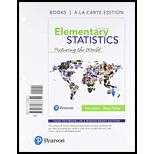
Concept explainers
Using an Inappropriate Test Discuss the nonparametric tests described in this chapter and match each test with its parametric counterpart, which you studied in earlier chapters.
To discuss: The nonparametric tests and match each test with its parametric counterpart.
Answer to Problem 2UA
Nonparametric tests:
Sign test: It is used for testing population median.
Wilcoxon signed rank test: It is used for testing two samples of the dependent groups come from the population having same distribution or not.
Wilcoxon rank sum test: It is used for testing two samples of the independent groups come from the population having same distribution or not.
Spearman rank correlation coefficient test: It is used for testing whether there is relation between two variables or not.
Run test: It is used for testing whether the sample is drawn randomly or not.
Kruskal-Wallis test: It is used for testing three or more samples come from the population having same distribution or not.
Match the nonparametric test with its parametric counterpart:
| Nonparametric test | Parametric test |
| Wilcoxon signed-rank test | t test for two dependent samples |
| Wilcoxon rank sum test | z and t test for two independent samples |
| Kruskal-Wallis test | One-way ANOVA |
| Spearman rank correlation | Pearson correlation |
Explanation of Solution
Non-parametric tests:
When the distribution of the population is not known or when the population distribution does not follow normality, then the non-parametric statistical tests are used to test the population parameters.
The non-parametric tests are listed below:
- Sign test
- Wilcoxon signed-rank test
- Wilcoxon rank sum test
- Kruskal-Wallis test
- Spearman rank correlation
- Run test
Sign test: It is used for testing population median.
Wilcoxon signed rank test: It is used to compare ranks the population of the paired samples or the matched samples. This implies that the Wilcoxon sign rank test is used to compare the matched pair groups. Moreover, it is used for testing two samples of the dependent groups come from the population having same distribution or not.
Wilcoxon rank sum test: It is used to compare the population ranks of the two different or independent samples. Moreover, it is used for testing two samples of the independent groups come from the population having same distribution or not.
Spearman rank correlation coefficient test: It is used for testing whether there is relation between two variables or not.
Run test: It is used for testing whether the sample is drawn randomly or not.
Kruskal-Wallis test: It is used for testing three or more samples come from the population having same distribution or not.
Parametric tests:
When the distribution of the population is known or when the population distribution follows normality, then the parametric statistical tests are used to test the population parameters.
Match the nonparametric test with its parametric counterpart:
| Nonparametric test | Parametric test |
| Wilcoxon signed-rank test | t test for two dependent samples |
| Wilcoxon rank sum test | z and t test for two independent samples |
| Kruskal-Wallis test | One-way ANOVA |
| Spearman rank correlation | Pearson correlation |
Want to see more full solutions like this?
Chapter 11 Solutions
ELEMENTARY STATISTICS W/MYMATHLAB<CUSTM
- A company found that the daily sales revenue of its flagship product follows a normal distribution with a mean of $4500 and a standard deviation of $450. The company defines a "high-sales day" that is, any day with sales exceeding $4800. please provide a step by step on how to get the answers in excel Q: What percentage of days can the company expect to have "high-sales days" or sales greater than $4800? Q: What is the sales revenue threshold for the bottom 10% of days? (please note that 10% refers to the probability/area under bell curve towards the lower tail of bell curve) Provide answers in the yellow cellsarrow_forwardFind the critical value for a left-tailed test using the F distribution with a 0.025, degrees of freedom in the numerator=12, and degrees of freedom in the denominator = 50. A portion of the table of critical values of the F-distribution is provided. Click the icon to view the partial table of critical values of the F-distribution. What is the critical value? (Round to two decimal places as needed.)arrow_forwardA retail store manager claims that the average daily sales of the store are $1,500. You aim to test whether the actual average daily sales differ significantly from this claimed value. You can provide your answer by inserting a text box and the answer must include: Null hypothesis, Alternative hypothesis, Show answer (output table/summary table), and Conclusion based on the P value. Showing the calculation is a must. If calculation is missing,so please provide a step by step on the answers Numerical answers in the yellow cellsarrow_forward
 Trigonometry (MindTap Course List)TrigonometryISBN:9781305652224Author:Charles P. McKeague, Mark D. TurnerPublisher:Cengage LearningAlgebra & Trigonometry with Analytic GeometryAlgebraISBN:9781133382119Author:SwokowskiPublisher:Cengage
Trigonometry (MindTap Course List)TrigonometryISBN:9781305652224Author:Charles P. McKeague, Mark D. TurnerPublisher:Cengage LearningAlgebra & Trigonometry with Analytic GeometryAlgebraISBN:9781133382119Author:SwokowskiPublisher:Cengage Holt Mcdougal Larson Pre-algebra: Student Edition...AlgebraISBN:9780547587776Author:HOLT MCDOUGALPublisher:HOLT MCDOUGAL
Holt Mcdougal Larson Pre-algebra: Student Edition...AlgebraISBN:9780547587776Author:HOLT MCDOUGALPublisher:HOLT MCDOUGAL Glencoe Algebra 1, Student Edition, 9780079039897...AlgebraISBN:9780079039897Author:CarterPublisher:McGraw Hill
Glencoe Algebra 1, Student Edition, 9780079039897...AlgebraISBN:9780079039897Author:CarterPublisher:McGraw Hill



